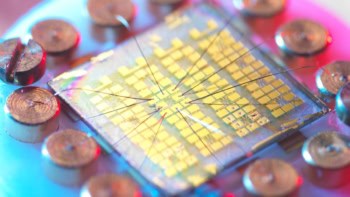
Researchers in Japan have unveiled a prototype of a “Mott transistor”. If implemented commercially, such a transistor could offer significant advantages over current designs in energy efficiency and switching speed.
As transistors are the basis of modern electronics, scientists are continually seeking ways to improve and enhance them. Transistors used for switching in modern computers are based on the field effect. In such transistors, a voltage applied between the gate and drain electrodes increases the conductivity of a semiconductor, allowing electricity to flow between the source and drain electrodes. A transistor should ideally carry as little current as possible when there is no voltage between the gate and drain (the off state) and as much as possible when gate voltage is present (the on state). A low off current is important for energy efficiency, while a large on current is important because it allows circuits to run faster.
Ideal transistor
An ideal transistor would be a total insulator in the off state and a perfect conductor in the on state. Therefore, an important measure of the quality of a transistor is the ratio of the on current to the off current. However, with a standard field-effect transistor (FET), this change in conductivity is influenced by only a thin layer close to where the current flows between gate and drain. This limits the ratio of on current to off current that can be achieved.
Scientists have suggested that it might be possible to improve this ratio by exploiting Mott insulators in transistors. Mott insulators are materials that should behave as metals according to conventional band theories but that act as insulators under certain conditions owing to quantum-mechanical correlations between neighbouring electrons. For reasons that are complex and not entirely understood, however, sudden phase transitions can be induced between the insulating state and the metallic state. Among other things, this metal–insulator transition can be induced by an electric field. While the gate voltage in an ordinary transistor simply modulates the resistance of a semiconductor, the gate voltage in a Mott transistor could turn an insulator into a metal.
Bulk transitions
Various research groups have tried to produce Mott transistors in the past, but they have failed to generate the electric fields needed to induce the metal–insulator transition at the surface of the Mott insulator. Now, scientists from the RIKEN Advance Science Institute in Wako, Japan, have covered the surface of the vanadium-dioxide Mott insulator with a drop of ionic liquid. When a small gate voltage was applied to the ionic liquid, this generated a huge electric field at the surface of the Mott insulator, inducing it to change to the metallic state. Best of all, unlike in a standard transistor, the phase transition – and so the change in conductivity – occurred not just at the surface, but also throughout the entire bulk of the material. The researchers are not entirely clear why this is the case, but they suspect that the electric field at the surface of the Mott insulator induces a phase transition in a thin layer near the surface, and that this introduces energy to the lattice of the material, thereby triggering a kind of cascade effect with the phase boundary propagating into the material like a wave.
The researchers achieved an on current to off current ratio of 100:1. This might seem disappointing alongside the figures for modern FETs, which can achieve ratios as high as a million to one, but Jochen Mannhart, a condensed-matter physicist at the Max Planck Institute for Solid State Research in Stuttgart, Germany, insists that is not the case. “The most significant feature of this research”, he says, “is that the researchers showed that in some material – in this case vanadium dioxide – by applying a gate voltage one can switch the whole volume of the material from being insulating to being conducting and thereby switch a very large volume of electrons from being immobile to being mobile.” He explains that, while the modern FET is the result of 30 years of optimization, the Mott transistor is a proof of principle and has not been optimized at all. Mannhart says the only real problem for the device is the presence of the ionic liquid, which would be impractical in a real circuit component and will need to be replaced by a solid insulator.
Masaki Nakano, who led the research, agrees that will be important, but he says that, for the moment, the group is not focusing on developing its device further. “Currently, we still have to spend a lot of time understanding our device,” he explains, “and there are many things still unclear.”
The research is published in Nature.



